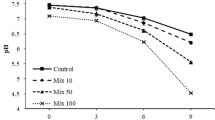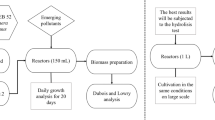Abstract
Pharmaceuticals (mostly antibiotics and non-steroid anti-inflammatory drugs) are hazardous micropollutants (HMP). Incomplete degradation of the HMP leads to their persistence in the environment and a plethora of deleterious effects. Conventional wastewater treatment cannot remove HMP completely, and a promising alternative is comprised by biotechnologies based on microalgae. Bioprospecting of HMP-tolerant strains is a bottleneck for such technologies. Carrying out a full-featured testing procedure for each newly isolated culture is impractical. Rapid screening can save a lot of time, money, and labor by selecting the efficient strains for further characterization or finding the concentration range where the strain exhibits the highest tolerance. The suitability of two well-plate screening techniques, one based on wet spectrophotometric assay of photosynthetic pigments together with an alternative method based on PAM imaging of chlorophyll variable fluorescence, was tested. Five pharmaceuticals (azithromycin, cephtriaxone, amoxiclav, diclofenac, ibuprofen) and five original strains (Micractinium simplicissimum NAMSU F2, Desmodesmus sp. IPPAS S-2014, Chlorella vulgaris IPPAS C-2015, Synechococcus sp. IPPAS B-2053, Lobosphaera sp. IPPAS C-2047) have been involved in the screening. Both approaches proved to be suitable for rapid screening of the tolerance of the studied microalgal strains to the toxicity of the studied pharmaceuticals. The imaging PAM–based technique better resolved the rapid changes in the microalgal cell condition. The wet pigment assay better highlighted the effects developing on the time scale of days. Interestingly, Chlorella and Desmodesmus incubated with a low concentration of the pharmaceuticals displayed some stimulatory effects. Precautions necessary for using these methods including the measurement setup, the choice of light intensity, and other possible caveats are discussed.



Similar content being viewed by others
Data availability
The datasets generated during the current study are available from the corresponding author on reasonable request.
References
Al-Momani IF (2001) Spectrophotometric determination of selected cephalosporins in drug formulations using flow injection analysis. J Pharm Biomed Anal 25:751-757
Anonymous (2020) Thermo Application Note AN53349. https://assets.thermofisher.com/TFS-Assets/MSD/Application-Notes/AN53349-spectrophotometric-analysis-ibuprofen.pdf; searched on 18 October 2021
Antal T, Konyukhov I, Volgusheva A, Plyusnina T, Khruschev S, Kukarskikh G, Goryachev S, Rubin A (2019) Chlorophyll fluorescence induction and relaxation system for the continuous monitoring of photosynthetic capacity in photobioreactors. Physiol Plant 165:476-486
Costa F, Lago A, Rocha V, Barros Ó, Costa L, Vipotnik Z, Silva B, Tavares T (2019) A review on biological processes for pharmaceuticals wastes abatement—a growing threat to modern society. Environ Sci Technol 53:7185-7202
Fallah Z, Zare EN, Ghomi M, Ahmadijokani F, Amini M, Tajbakhsh M, Arjmand M, Sharma G, Ali H, Ahmad A, Makvandi P, Lichtfouse E, Sillanpää M, Varma RS (2021) Toxicity and remediation of pharmaceuticals and pesticides using metal oxides and carbon nanomaterials. Chemosphere 275:130055
Giang DT, Hoang VD (2010) Comparative study of RP-HPLC and UV spectrophotometric techniques for the simultaneous determination of amoxicillin and cloxacillin in capsules. J Young Pharm 2:190-195
Grzesiuk M, Wacker A, Spijkerman E (2016) Photosynthetic sensitivity of phytoplankton against commonly used pharmaceuticals and its dependence on cellular phosphorus status. Ecotoxicology 25:697-707
Grzesiuk M, Spijkerman E, Lachmann SC, Wacker A (2018) Environmental concentrations of pharmaceuticals directly affect phytoplankton and effects propagate through trophic interactions. Ecotoxicol Environ Saf 156:271-278
Hiller CX, Hübner U, Fajnorova S, Schwartz T, Drewes JE (2019) Antibiotic microbial resistance (AMR) removal efficiencies by conventional and advanced wastewater treatment processes: a review. Sci Total Environ 685:596-608
Jayanna BK, Nagendrappa G, Arunkumar NG (2012) Spectrophotometric estimation of azithromycin in tablets. Indian J Pharm Sci 74:365-367
Joshi Y, Chaudhary RK, Teotia UVS (2014) In vitro evaluation of release modifying potential of Prunus persica gum in matrix tablets. Res J Pharm Dosage Forms Technol 18:18-25
Kalaji HM, Schansker G, Brestic M, Bussotti F, Calatayud A, Ferroni L, Goltsev V, Guidi L, Jajoo A, Li P, Losciale P, Mishra VK, Misra AN, Nebauer SG, Pancaldi S, Penella C, Pollastrini M, Suresh K, Tambussi E, Yanniccari M, Zivcak M, Cetner MD, Samborska IA, Stirbet A, Olsovska K, Kunderlikova K, Shelonzek H, Rusinowski S, Baba W (2017) Frequently asked questions about chlorophyll fluorescence, the sequel. Photosynth Res 132:13-66
Kiki C, Rashid A, Wang Y, Li Y, Zeng Q, Yu C-P, Sun Q (2020) Dissipation of antibiotics by microalgae: kinetics, identification of transformation products and pathways. J Hazard Mat 387:121985
Leng L, Wei L, Xiong Q, Xu S, Li W, Lv S, Lu Q, Wan L, Wen Z, Zhou W (2020) Use of microalgae based technology for the removal of antibiotics from wastewater: a review. Chemosphere 238:124680
Manaia CM, Rocha J, Scaccia N, Marano R, Radu E, Biancullo F, Cerqueira F, Fortunato G, Iakovides IC, Zammit I, Kampouris I, Vaz-Moreira I, Nunes OC (2018) Antibiotic resistance in wastewater treatment plants: tackling the black box. Environ Int 115:312–324
Muñoz I, Rieradevall J, Torrades F, Peral J, Domènech X (2005) Environmental assessment of different solar driven advanced oxidation processes. Sol Energy 79:369-375
Ncibi MC, Mahjoub B, Mahjoub O, Sillanpää M (2017) Remediation of emerging pollutants in contaminated wastewater and aquatic environments: biomass-based technologies. CLEAN – Soil, Air, Water 45:1700101 .
Nguyen TT, Nam SN, Son J, Oh J (2019) Tungsten trioxide (WO 3)-assisted photocatalytic degradation of amoxicillin by simulated solar irradiation. Sci Rep 9(1):1–18
Popovic R, Dewez D, Juneau P (2003) Applications of chlorophyll fluorescence in ecotoxicology: heavy metals, herbicides, and air pollutants.In: DeEll PMA JR, Toivonen PMA (eds) Practical applications of chlorophyll fluorescence in plant biology. Springer, Boston, p 151–184
Purushanahalli SC, Sanyal D, Dasgupta S, Banik A (2021) Phycoremediation and photosynthetic toxicity assessment of lead by two freshwater microalgae Scenedesmus acutus and Chlorella pyrenoidosa. Physiol Plant 173:246-258
Rodriguez-Mozaz S, Chamorro S, Marti E, Huerta B, Gros M, Sanchez-Melsio A, Borrego CM, Barcelo D, Balcazar JL (2015) Occurrence of antibiotics and antibiotic resistance genes in hospital and urban wastewaters and their impact on the receiving river. Water Res 69:234-242
Simon M, Joshi H (2021) A review on green technologies for the rejuvenation of polluted surface water bodies: field-scale feasibility challenges and future perspectives. J Environ Chem Eng 9:105763
Solovchenko A, Khozin-Goldberg I, Cohen Z, Merzlyak M (2009) Carotenoid-to-chlorophyll ratio as a proxy for assay of total fatty acids and arachidonic acid content in the green microalga Parietochloris incisa. J Appl Phycol 21:361-366
Solovchenko A, Merzlyak M, Khozin-Goldberg I, Cohen Z, Boussiba S (2010) Coordinated carotenoid and lipid syntheses induced in Parietochloris incisa (Chlorophyta, Trebouxiophyceae) mutant deficient in Δ5 desaturase by nitrogen starvation and high light. J Phycol 46:763-772
Solovchenko A, Solovchenko O, Khozin-Goldberg I, Didi-Cohen S, Pal D, Cohen Z, Boussiba S (2013) Probing the effects of high-light stress on pigment and lipid metabolism in nitrogen-starving microalgae by measuring chlorophyll fluorescence transients: studies with a Δ5 desaturase mutant of Parietochloris incisa (Chlorophyta, Trebouxiophyceae). Algal Res 2:175-182
Stanier R, Kunisawa R, Mandel M, Cohen-Bazire G (1971) Purification and properties of unicellular blue-green algae (order Chroococcales). Bacteriol Rev 35:171-205
Strasser R, Tsimilli-Michael M, Srivastava A (2004) Analysis of the chlorophyll a fluorescence transient. In: Papageorgiou G, Govindjee (eds) Chlorophyll a fluorescence: a signature of photosynthesis. Springer, Boston MA, pp 321–362.
Wang J, Chu L, Wojnarovits L, Takacs E (2020) Occurrence and fate of antibiotics, antibiotic resistant genes (ARGs) and antibiotic resistant bacteria (ARB) in municipal wastewater treatment plant: an overview. Sci Total Environ 744: 140997
Zhang Y, Guo J, Yao T, Zhang Y, Zhou X, Chu H (2019) The influence of four pharmaceuticals on Chlorella pyrenoidosa culture. Sci Rep 9:1-10
Acknowledgements
This work was partially supported by the Ministry of Science and Higher Education of the Russian Federation in the framework of agreement № 075-15-2021-709 (unique project identifier RF2296.61321X0037).
Funding
Financial support by the Russian Science Foundation (project 21-74-20004: microalgae cultivation and wet assays; project 20-64-46018: PAM measurements) is gratefully acknowledged.
Author information
Authors and Affiliations
Corresponding author
Ethics declarations
Conflict of interest
The authors declare no competing interests.
Additional information
Publisher's note
Springer Nature remains neutral with regard to jurisdictional claims in published maps and institutional affiliations.
Supplementary Information
Below is the link to the electronic supplementary material.
Supplementary file 1
(PDF 9.82 MB)
Rights and permissions
About this article
Cite this article
Solovchenko, A.E., Vasilieva, S.G., Zaitsev, P. et al. Approaches to rapid screening of pharmaceutical xenobiotic effects on microalgae via monitoring of photosynthetic apparatus condition. J Appl Phycol 34, 353–361 (2022). https://doi.org/10.1007/s10811-021-02660-4
Received:
Revised:
Accepted:
Published:
Issue Date:
DOI: https://doi.org/10.1007/s10811-021-02660-4




